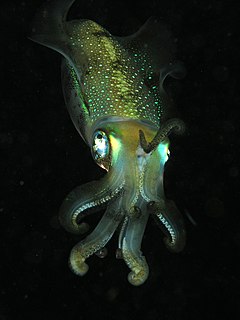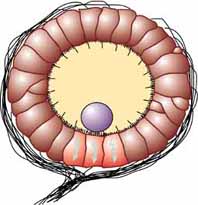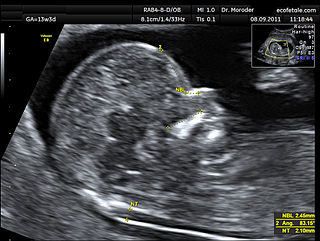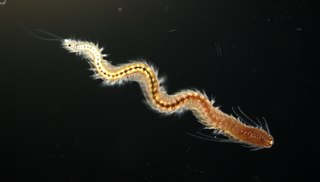
A cephalopod is any member of the molluscan class Cephalopoda such as a squid, octopus, or nautilus. These exclusively marine animals are characterized by bilateral body symmetry, a prominent head, and a set of arms or tentacles modified from the primitive molluscan foot. Fishermen sometimes call cephalopods "inkfish," referring to their common ability to squirt ink. The study of cephalopods is a branch of malacology known as teuthology.

The Sipuncula or Sipunculida is a group containing about 162 species of bilaterally symmetrical, unsegmented marine worms. The name Sipuncula is from the genus name Sipunculus, and comes from the Latin siphunculus meaning a "small tube". Traditionally considered a phylum, Sipuncula seems to be closely related to Myzostomida and Annelida, and may be a subgroup of Annelida, based on recent molecular work. Sipunculans vary in size but most species are under 10 cm (4 in) in length.

The Polychaeta, also known as the bristle worms or polychaetes, are a paraphyletic class of annelid worms, generally marine. Each body segment has a pair of fleshy protrusions called parapodia that bear many bristles, called chaetae, which are made of chitin. As such, polychaetes are sometimes referred to as bristle worms. More than 10,000 species are described in this class. Common representatives include the lugworm and the sandworm or clam worm Alitta.

Monoplacophora, meaning "bearing one plate", is a polyphyletic superclass of molluscs with a cap-like shell now living at the bottom of the deep sea. Extant representatives were not recognized as such until 1952; previously they were known only from the fossil record.

The statocyst is a balance sensory receptor present in some aquatic invertebrates, including molluscs, bivalves, cnidarians, ctenophorans, echinoderms, cephalopods, and crustaceans. A similar structure is also found in Xenoturbella. The statocyst consists of a sac-like structure containing a mineralised mass (statolith) and numerous innervated sensory hairs (setae). The statolith's inertia causes it to push against the setae when the animal accelerates. Deflection of setae by the statolith in response to gravity activates neurons, providing feedback to the animal on change in orientation and allowing balance to be maintained.
Schizocoely is a process by which some animal embryos develop. The schizocoely mechanism occurs when secondary body cavities (coeloms) are formed by splitting a solid mass of mesodermal embryonic tissue.

A nuchal cord is when the umbilical cord becomes wrapped around the fetus's neck. Symptoms present in the baby shortly after birth from a prior nuchal cord may include duskiness of face, facial petechia, and bleeding in the whites of the eye. Complications can include meconium, respiratory distress, anemia, and stillbirth. Multiple wraps are associated with greater risk.

A nuchal scan or nuchal translucency (NT) scan/procedure is a sonographic prenatal screening scan (ultrasound) to detect chromosomal abnormalities in a fetus, though altered extracellular matrix composition and limited lymphatic drainage can also be detected.

Odontogriphus is a genus of soft-bodied animals known from middle Cambrian Lagerstätte. Reaching as much as 12.5 centimetres (4.9 in) in length, Odontogriphus is a flat, oval bilaterian which apparently had a single muscular foot, and a "shell" on its back that was moderately rigid but of a material unsuited to fossilization.
Promachoteuthis sulcus is a species of promachoteuthid squid. It is distinguished from related taxa on the basis of several morphological features: nuchal fusion between the head and mantle, much larger size of arm suckers compared to club suckers, greater width of tentacle base than arm base, a recessed club base, and the presence of an aboral tentacle groove.

All cephalopods possess flexible limbs extending from their heads and surrounding their beaks. These appendages, which function as muscular hydrostats, have been variously termed arms, legs or tentacles.
engrailed is a homeodomain transcription factor involved in many aspects of multicellular development. First known for its role in arthropod embryological development, working in consort with the Hox genes, engrailed has been found to be important in other areas of development. It has been identified in many bilaterians, including the vertebrates, echinoderms, molluscs, nematodes, brachiopods, and polychaetes. It acts as a "selector" gene, conferring a specific identity to defined areas of the body, and co-ordinating the expression of downstream genes.

A radiole is a heavily ciliated feather-like tentacle found in highly organized clusters on the crowns of Canalipalpata. Canalipalpata is an order of sessile marine polychaete worms consisting of 31 families. These benthic annelid tube worms employ radioles primarily for alimentation. While their primary role is to function as an organ for filter feeding, radioles also serve as respiratory organs. Because of their role in gas exchange, radioles are often referred to as "gills".

A sucker in zoology refers to specialised attachment organ of an animal. It acts as an adhesion device in parasitic worms, several flatworms, cephalopods, certain fishes, amphibians, and bats. It is a muscular structure for suction on a host or substrate. In parasitic annelids, flatworms and roundworms, suckers are the organs of attachment to the host tissues. In tapeworms and flukes, they are a parasitic adaptation for attachment on the internal tissues of the host, such as intestines and blood vessels. In roundworms and flatworms they serve as attachment between individuals particularly during mating. In annelids, a sucker can be both a functional mouth and a locomotory organ. The structure and number of suckers are often used as basic taxonomic diagnosis between different species, since they are unique in each species. In tapeworms there are two distinct classes of suckers, namely "bothridia" for true suckers, and "bothria" for false suckers. In digeneal flukes there are usually an oral sucker at the mouth and a ventral sucker posterior to the mouth. Roundworms have their sucker just in front of the anus; hence it is often called a pre-anal sucker.

Platynereis dumerilii is a species of annelid polychaete worm. It was originally placed into the genus Nereis and later reassigned to the genus Platynereis. Platynereis dumerilii lives in coastal marine waters from temperate to tropical zones. It can be found in a wide range from the Azores, the Mediterranean, in the North Sea, the English Channel, and the Atlantic down to the Cape of Good Hope, in the Black Sea, the Red Sea, the Persian Gulf, the Sea of Japan, the Pacific, and the Kerguelen Islands. Platynereis dumerilii is today an important lab animal, it is considered as a living fossil, and it is used in many phylogenetic studies as a model organism.

Biomineralising polychaetes are polychaetes that biomineralize.
Acetabulum in invertebrate zoology is a saucer-shaped organ of attachment in some annelid worms and flatworms. It is a specialised sucker for parasitic adaptation in trematodes by which the worms are able to attach on the host. In annelids, it is basically a locomotory organ for attaching to a substratum. The name also applies to the suction appendage on the arms of cephalopod molluscs such as squid, octopus, cuttlefish, Nautilus, etc.

The annelids, also known as the ringed worms or segmented worms, are a large phylum, with over 22,000 extant species including ragworms, earthworms, and leeches. The species exist in and have adapted to various ecologies – some in marine environments as distinct as tidal zones and hydrothermal vents, others in fresh water, and yet others in moist terrestrial environments.
Parergodrilidae is an enigmatic family of polychaetes with only two genera, one living on the coast, the other terrestrial.
Potamodrilidae is a family of meiofaunal annelids, only containing the European genus Potamodrilus. It's the sister group to Aeolosomatidae, by all accounts. Beyond that, its phylogenetic position is uncertain.

















